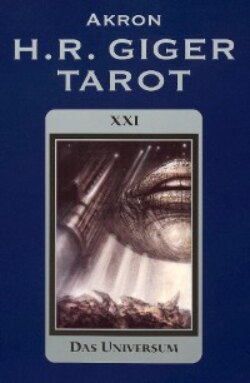Читать книгу H. R. GIGER TAROT - H. R. Giger - Страница 13
ОглавлениеIII THE MIRROR OF THE SOUL
Questions
The Mirror of the Soul is the appropriate spread to use when there are two different things you want to know: first, what inner images of your own are you projecting onto the situation (spread I). Second, what external experiences arise out of it (spread II)? This means that this is a matter of recognizing in which form what you have evoked is translated into reality from the reflection and/or in what guise you encounter your inner images in external life.
Background
This method of laying the cards combines spreads I and II.
Interpretation
1 The Ego
The first card represents the consciousness of your own self (The Great Spirit). It is the way the subject expresses and perceives itself as such: this is your own conscious identity at this time.
2 The Image of the Ego
The second card shows you the aim of your identity (John Dee); this is the inner intention, which is the basis of the course you are following and leads you to your conscious identity.
3 The Other
The third card describes the challenge created by the encounter with the world (the Horned God): this is what confronts you from the outside as your environment.
4 The Image of the Other
The fourth card symbolizes the part of you that you have distanced from yourself and projected onto the opposite sex (Jane), which is reflected in the image of the partner.
5 The Id
The fifth card describes – in contrast to the conscious ego – the deeper layers of the personality (The Devil): the level of the soul that includes the unconscious, the emotions, feelings, drives, and strivings (“endothymus function”).
6 The Image of the Id
The sixth card shows the circumstances or the person through which evil surfaces in life (Edward Kelley), the clothing in which the Id is manifested.
7 The Superego
This card embodies the superego in the Freudian sense, the controlling authority (the hidden one) placed above the ego, which accepts that the laws of society are valid and binding. It therefore includes the moral regulations and opportunistic aspirations of our spiritual life.
8 The Image of the Superego
In the eighth card you encounter father figure (Rabbi Löw), who is inspired by the endeavor for a better solutions. He breaks through the barriers of perception and grows within the transcendental spaces of limitless levels of consciousness. As an authority that passes judgment according to your conscience, he mainly demands that we renounce the goals for which the id strives (cards 5 and 6) and places himself in opposition to the ego (card 1). In unresolved conflict situations, this can lead to repression of the desires or emotions unacceptable to the superego.
9 The Darkness (The Shadow of the Light)
The ninth card shows us the purposeful currents rising from the endothymus function (card 5); these are often tied to feelings. As motivating forces, they determine the dynamics of experience, desires, and action. On the archetypal level, this is the Great Unknown or the dark archetype (the Green Angel), which attracts you and places you at its whose mercy if you fall into its hands.
10 The Light (The Shadow of the Darkness)
The last card shows the higher understanding through which the human spirit rises above itself and can become aware of its own bicephalous nature (Baphomet) by recognizing itself from both inside and outside of its own ways of thinking. He is the Janus-headed figure who unites an inward view with an outward glance in a dual perspective: “I am the Devil who has overcome polarities by looking God in the eye and only seeing himself.”
